How to Paint Skin Tones – One Layer at a Time
There’s a Zen to painting in layers.
You have got to enjoy the process or this isn’t the method for you….(but don’t worry, there are lots of ways to paint a portrait & get a similar result). Personally I like any way that is easy. And this is pretty easy – but alas, it isn’t fast ’cause you just have to wait for those layers to dry before moving on.
“It is good to have an end to journey toward, but it is the journey that matters, in the end.”
-Ursula K. LeGuin
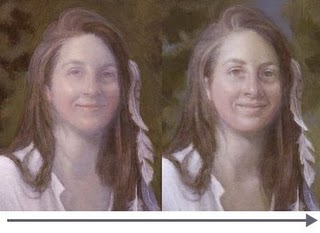
On the left side is a picture of the last completed layer (uncorrected).
On the right is the current layer (uncorrected).
That short journey from left to right is the subject of this little mini- demo on how to paint a layer on a face. (Of course, the same process works for hands, feet, all skin showing).
I use this method (multiple layers) to build light and form in small increments in order to get the luminosity of the Old Masters.
The more layers I paint – the more luminous it gets.
This example is only one of the many “middle layers” and merely illustrates a small (and relatively easy) step that goes into painting a portrait.
This particular face is small, only 3.25 inches high and this entire layer (shown) here only takes me half an hour (more or less). It is a lot easier and faster than it looks – really!
The hard part is waiting for my paint to dry so I can begin to build the next layer.
While I wait, however, I work on background, clothing, props, other paintings, this blog, run errands, eat lunch…you get the idea.
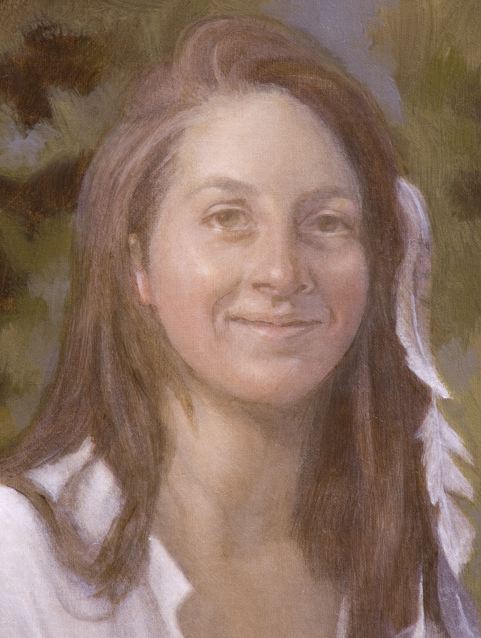
This is the corrected face from the last demo on losing/finding a likeness. It is now ready for yet another layer.
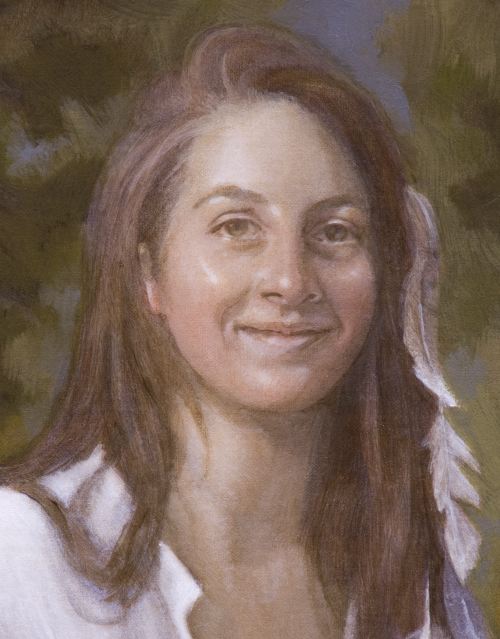
I begin by reinforcing the lights (Titanium White) and the darks (Raw Umber thinned with Liquin) to increase the contrast. I try to avoid hard edges in this.
I let this dry thoroughly (i.e., overnight).

This is the palette I use in a layer. It does not matter if the skin tone is light or dark…the colors are the same but obviously the values will be different.
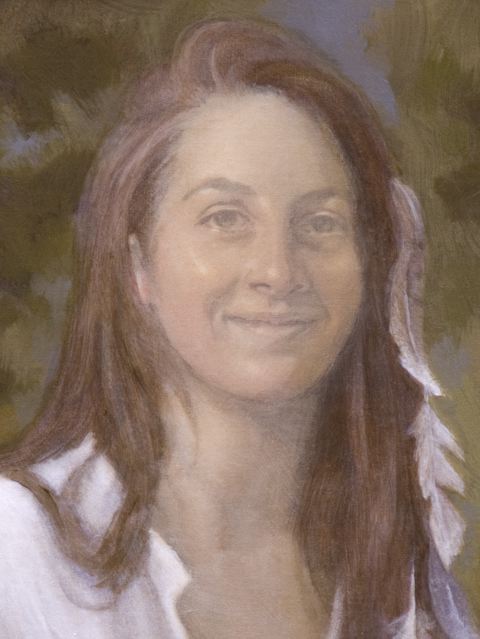
I mix/match the approximate skin tone (raw umber, burnt umber, raw sienna, titanium white), mix it with Liquin and scumble it over the entire face.
Note that my paint is never so thick that I cannot see through it to the layer below.
See why I reinforced the darks & lights to bump up the contrast?
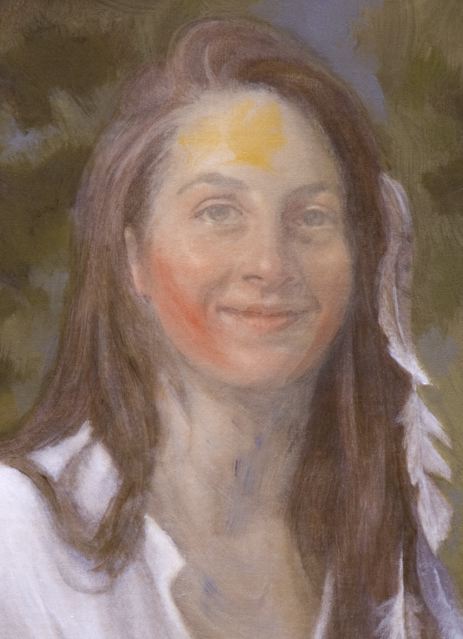
Into the wet surface, I add color. See my demo on Old Master Color Banding in Portraiture for particulars.
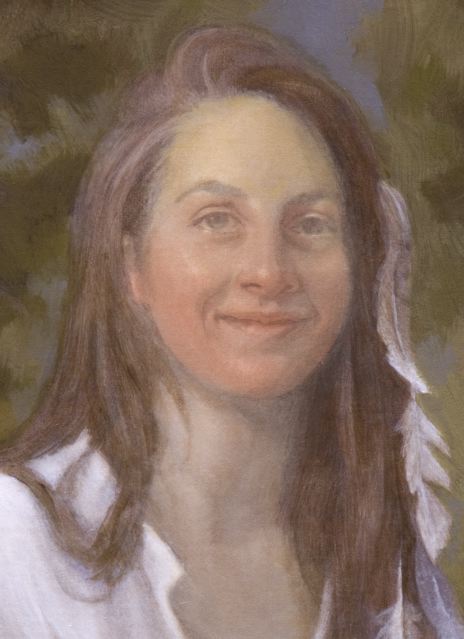
I blend those colors in.
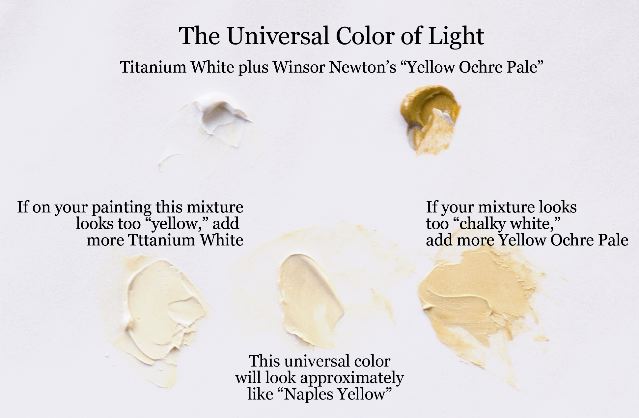
This is how I mix “The Universal Color of Light.”
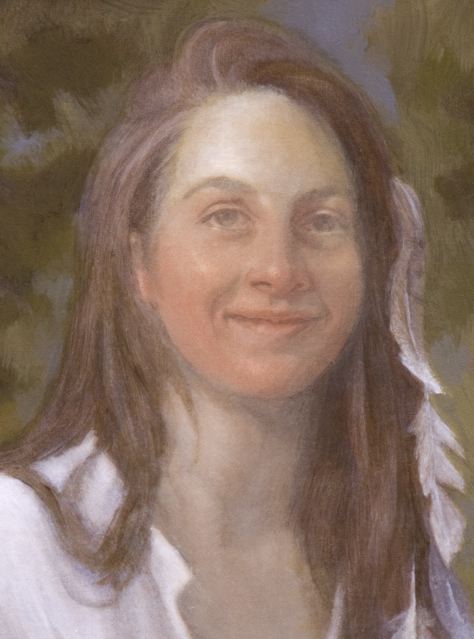
I use this “Universal Color of Light” to build light on the face (or just about anywhere).
If the light looks chalky, I add more yellow.
If the light looks too yellow, I add more white.
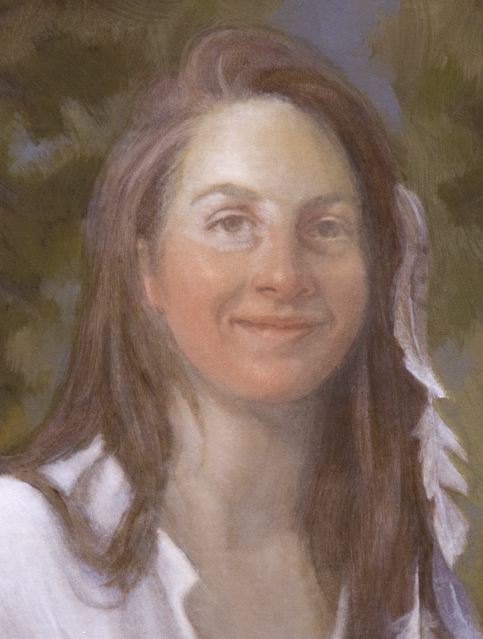
I continue pulling the light down into the face. I am only working with light – not color.
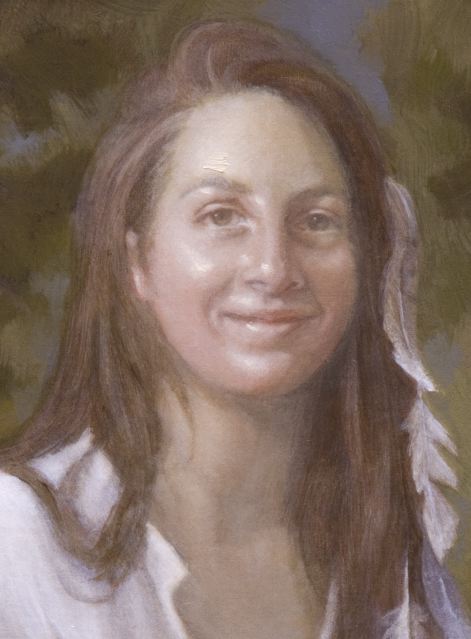
I continue adding light. I locate and reinforce the centers of light with thicker paint.
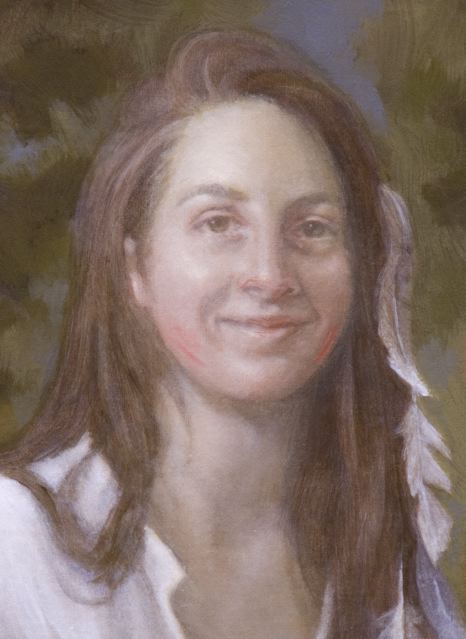
I add more light, work it in and let the light build and define the form.

I continue to define the form with light.
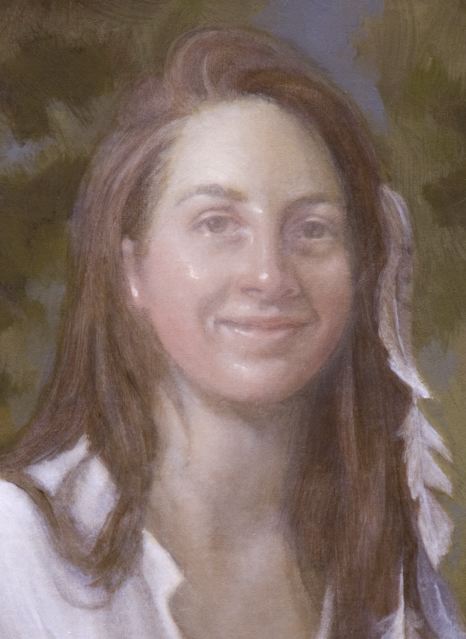
I add even more light into the centers of light (as defined by the highlights).
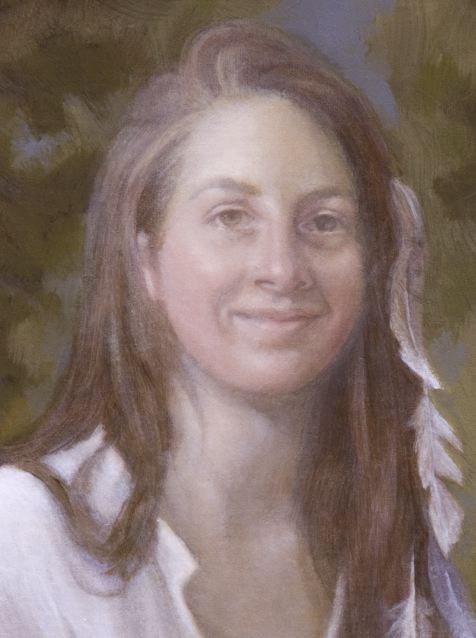
I work this light in and build form. I allow the light to go into the hair.
This layer is done and it must be allowed to dry thoroughly.
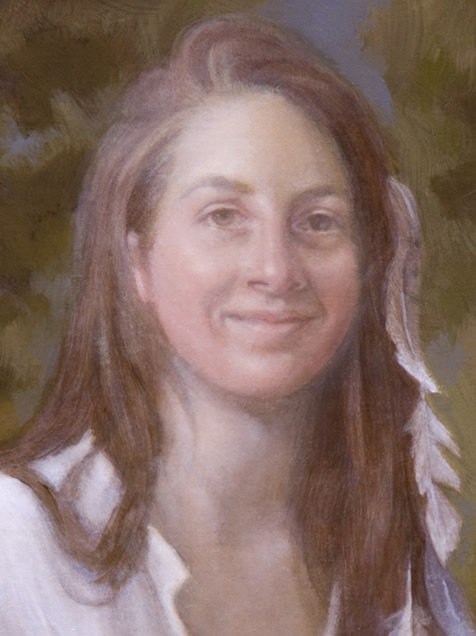
I did correct the above pix, then went on and painted the next layer below.
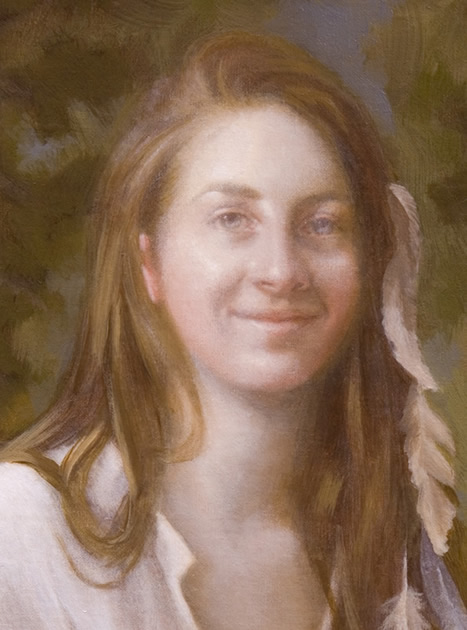
ABOVE: Here is a peek at the next layer (uncorrected as to likeness, without a skin tone glaze and ill-defined features). The light is now so thick you cannot see the weave of the canvas through it. I’ve started to work on the hair. I wish this photo wasn’t so small – it is really quite a jump forward.
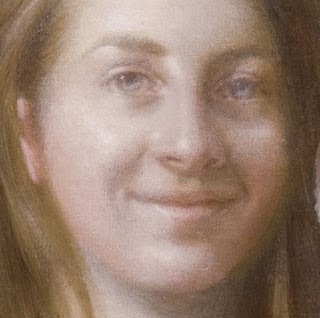
This is a detail. You can see the color locked underneath as I build light on this face.
Next:
*
I’ll correct the likeness and define the features with raw umber and let it dry.
*
Next I’ll glaze this back into a skin tone and let it dry.
*
Then I’ll match a scumble to the skin tone and work color (bands) into the face
*
I’ll let this dry – and repeat the process if necessary.
Considering how “unfinished” this stage looks right now, it is relatively quick and easy to transform a face with several layers of light into a finished face.
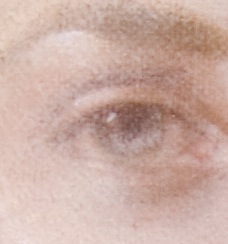
This is a detail showing how the light flows over the face with what is underneath still being visible. Do NOT paint around features like eyes, eyebrows – and don’t be afraid to paint over the entire face in order to define the light. It is the paint that shows through that gives a painting its subtle beauty of form.
NOTE: I usually do the face LAST as the skin tones are really determined by what surrounds it (i.e., the background). So I’m going to stop working on the face now and bring the rest of this painting into being before I get all the color into this face.
I just keep repeating this entire layering process until the face tells me when it is time to stop and finish.
“Everything the same; everything distinct.”
– Zen Proverb
I hope you enjoyed this lesson on how to paint skin tones. Find more portrait painting tutorials on our site here.
About Karin
Karin Wells is an artist of amazing versatility. She graduated with honors from both the New England School of Art and Design, Boston, 1965, and the Butera School of Art, Boston, 1986. Karin has enjoyed a career as an award-winning graphic designer, illustrator and sign painter. She also taught Life Drawing and Painting for many years. She has most recently studied for three years at The New England School of Classical Painting in Greenfield, New Hampshire, under the direction of Numael Pulido.
To expand her craft, Karin has traveled throughout Europe studying the Old Masters. Her art reflects the deep influence of these great works. Karin demonstrates a remarkable facility for likeness and for the use of light.
The artist is a member of The American Society of Portrait Artists, Portrait Society of America, The Portrait Society of Atlanta, and The Copley Society of Boston.
To learn more about Karin and to view more of her amazing work, be sure to visit her website and blog by following the links below:
Website: https://www.karinwells.com/
Blog: https://karinwells.blogspot.com/
If you would like to be notified when Karin updates her blog, be sure to click the “Follow” link in the upper left hand corner of her blog.
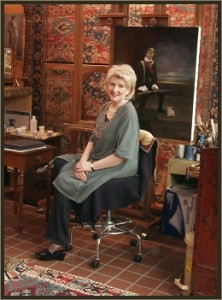
I like what you taught,I just wish it would have went into further detail. I also wish it would have started from the beginning. (You may have already done that, and I may have missed it and for that I am sorry.) I would love to see it from start to finish, or at least the finished product.
Good article, thank you for posting it. I would agree with Tammy -> It would be interesting to see all the steps from the beginning to the end.
i thank u for posting as well. i agree with the other two posting it would be very helpful if i could follow you from beginning to end.
Curious as to what colours you would bring into arms and hands.
I am working on one now that I am applying your techniques to, but brought the blue into the arms and hands and not sure I like it.
You’re work and teachings are amazing..
I really dont have any talent in painting,,im so glad to see this site and know the steps on how to paint.I would love to do but ill practice…
this is really amazing!!! it made portrait painting looks easier to me 🙂 now, i am more encouraged to to this! thank you very much!
I love your portrait painting! In regards to some of the smaller areas of a painting, such as the areas where pure titanium white applied, it seemed like the “lean” layer was over the “fat” layer. Perhaps I don’t need to worry about it because the theory of fat over lean does not apply in regards to small areas or certain points in the painting.
wonderful!taught us so many important things,i will recommend to other friends,thank you
Beautiful paintings.Exceedingly generous teacher.
Priceless.
Oh this is oilpaint…